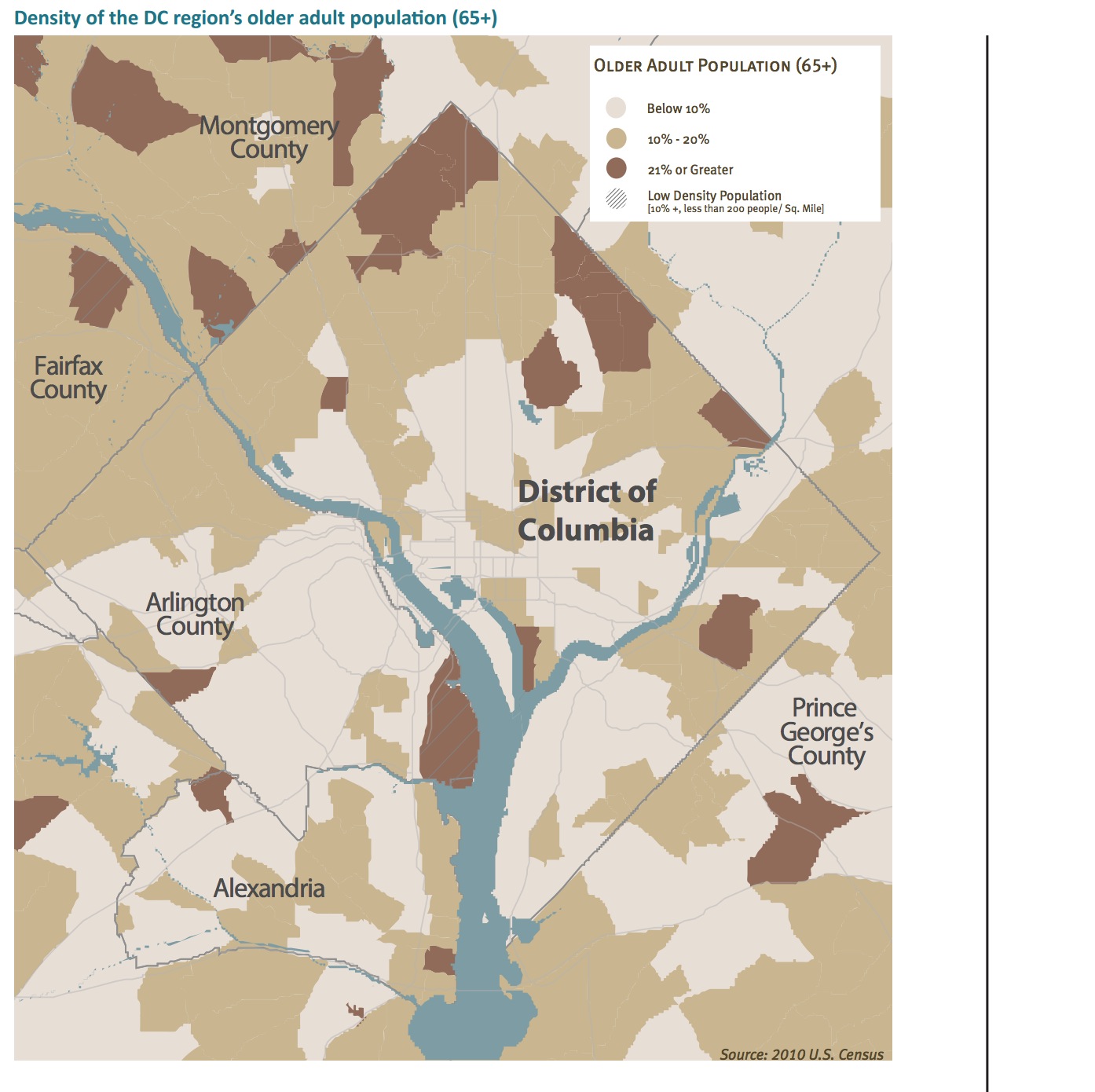COALITION FOR SMARTER GROWTH
EXECUTIVE SUMMARY
THE DISTRICT’S POPULATION IS AGING.
In the next 25 years, the number of Americans
aged 65 and over will double. By 2030, one of
every five Americans, or about 72 million people,
will be considered an older adult. The driving
forces behind this reality are increased life spans
and the aging of the baby boomer generation
— those born between 1946 and 1964. Baby
boomers in DC, who are an estimated 17
percent of the District of Columbia’s population,
represent a growing older cohort. Both their
presence and well being are important to
sustaining vibrant and inclusive neighborhoods.
The potential contributions to our neighborhoods
by older residents are undermined without
forward-thinking planning to address the growing
and unique needs of our oldest residents.
OLDER ADULTS WISH TO AGE IN THEIR OWN HOMES
OR NEIGHBORHOODS, AND REQUIRE ADEQUATE
TRANSPORTATION TO DO SO.
As DC residents age, many are likely to do so
either in their home or their neighborhood,
surrounded by familiar faces and places.
Residential options range from single-family
homes to multifamily buildings that offer
elevators and single-level living. Access to safe,
efficient, and affordable transportation— to
ensure older adults can get where they are going
and that their friends and family can reach them
too—is a crucial factor for older adults when
deciding among available residential options.
AGE-FRIENDLY TRANSPORTATION IS AN OPPORTUNITY
FOR RESIDENTS OF ALL AGES TO START AND KEEP
HEALTHY TRANSPORTATION HABITS THAT INCREASE
MOBILITY AND REDUCE ISOLATION.
Sensory and mobility loss commonly associated
with aging can make it difficult for older adults
to drive, but also make it harder to access and
use transit. This report focuses on transportation
policy and planning for the aging population
in the District of Columbia. More specifically,
it examines how to better target investments
and coordinate services that will both benefit
older adults, and make communities more
pedestrian and transit-friendly for all residents.
By addressing age-friendly transportation, our
communities also acknowledge related public
health issues, strengthen the local economy, and
promote universal design that is accommodating
to all users, regardless of age and ability.
This report addresses age-friendly transportation
by focusing on how to improve three key areas
of transportation: the pedestrian environment;
public transit; and coordinating paratransit,
community transportation, and private
transportation services.
CREATING PEDESTRIAN-FRIENDLY ENVIRONMENTS
Every trip starts and ends with a walk trip, made
either on foot or aided by a mobility device.
With that in mind, cities with complete streets
policies that accommodate all pedestrians are
the foundation of an age-friendly city. According
to Kathy Sykes, Senior Advisor of the EPA’s Aging
Initiative, “Making sure that there is adequate
time to cross intersections, good lighting
for visibility and safety at night, and having
connected sidewalks for those who use canes
or wheelchairs are some of the key things that
communities can provide.” These best practices
contribute to walkable, inclusive, and safer
neighborhoods. Together, these improve safety
and move the city toward a vision of zero traffic
fatalities.
DC Findings
The District of Columbia recognizes pedestrians
as a policy priority and has made significant
strides to improve pedestrian safety. Measures
like streetscape enhancements, improving safety
at crossings, using automatic enforcement
to reduce collisions and decrease speeding,
and increasing the number of bike lanes,
have continued to improve the pedestrian
environment for many. However, for DC to be
truly age-friendly there is still work to be done
to maintain sidewalks, fill sidewalk gaps, improve
data collection and reporting, and provide
appropriate public amenities.
Key Recommendations
- Dedicate adequate funding for sidewalk maintenance and repair in every fiscal year budget to ensure consistently safe streets and prevent further backlog in repairs.
- Collect and use data on collisions involving pedestrians and bicyclists to identify high-risk intersections, and make quarterly updates available to the public.
- Create an interagency team with DDOT, the Office of Planning, Department of Public Works, Department of Parks and Recreation, and the National Park Service to work with the Office on Aging and the Age-Friendly DC Initiative on increasing the number of senior-friendly public amenities, including sidewalk seating, quality lighting, and public restrooms.
Download full version (PDF): Moving an Age-Friendly DC
About the Coalition for Smarter Growth
www.smartergrowth.net
The Coalition for Smarter Growth is the leading organization in the Washington, D.C. region dedicated to making the case for smart growth. Our mission is to promote walkable, inclusive, and transit-oriented communities, and the land use and transportation policies and investments needed to make those communities flourish.
Tags: Coalition for Smarter Growth, D.C., District of Columbia, Washington







 RSS Feed
RSS Feed